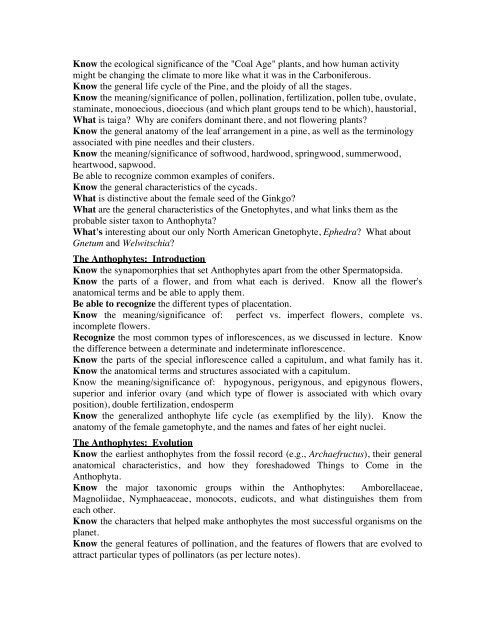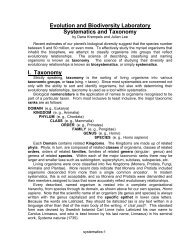Study Guide for the most recent material on the final exam
Study Guide for the most recent material on the final exam
Study Guide for the most recent material on the final exam
You also want an ePaper? Increase the reach of your titles
YUMPU automatically turns print PDFs into web optimized ePapers that Google loves.
Know <str<strong>on</strong>g>the</str<strong>on</strong>g> ecological significance of <str<strong>on</strong>g>the</str<strong>on</strong>g> "Coal Age" plants, and how human activitymight be changing <str<strong>on</strong>g>the</str<strong>on</strong>g> climate to more like what it was in <str<strong>on</strong>g>the</str<strong>on</strong>g> Carb<strong>on</strong>iferous.Know <str<strong>on</strong>g>the</str<strong>on</strong>g> general life cycle of <str<strong>on</strong>g>the</str<strong>on</strong>g> Pine, and <str<strong>on</strong>g>the</str<strong>on</strong>g> ploidy of all <str<strong>on</strong>g>the</str<strong>on</strong>g> stages.Know <str<strong>on</strong>g>the</str<strong>on</strong>g> meaning/significance of pollen, pollinati<strong>on</strong>, fertilizati<strong>on</strong>, pollen tube, ovulate,staminate, m<strong>on</strong>oecious, dioecious (and which plant groups tend to be which), haustorial,What is taiga? Why are c<strong>on</strong>ifers dominant <str<strong>on</strong>g>the</str<strong>on</strong>g>re, and not flowering plants?Know <str<strong>on</strong>g>the</str<strong>on</strong>g> general anatomy of <str<strong>on</strong>g>the</str<strong>on</strong>g> leaf arrangement in a pine, as well as <str<strong>on</strong>g>the</str<strong>on</strong>g> terminologyassociated with pine needles and <str<strong>on</strong>g>the</str<strong>on</strong>g>ir clusters.Know <str<strong>on</strong>g>the</str<strong>on</strong>g> meaning/significance of softwood, hardwood, springwood, summerwood,heartwood, sapwood.Be able to recognize comm<strong>on</strong> <strong>exam</strong>ples of c<strong>on</strong>ifers.Know <str<strong>on</strong>g>the</str<strong>on</strong>g> general characteristics of <str<strong>on</strong>g>the</str<strong>on</strong>g> cycads.What is distinctive about <str<strong>on</strong>g>the</str<strong>on</strong>g> female seed of <str<strong>on</strong>g>the</str<strong>on</strong>g> Ginkgo?What are <str<strong>on</strong>g>the</str<strong>on</strong>g> general characteristics of <str<strong>on</strong>g>the</str<strong>on</strong>g> Gnetophytes, and what links <str<strong>on</strong>g>the</str<strong>on</strong>g>m as <str<strong>on</strong>g>the</str<strong>on</strong>g>probable sister tax<strong>on</strong> to Anthophyta?What's interesting about our <strong>on</strong>ly North American Gnetophyte, Ephedra? What aboutGnetum and Welwitschia?The Anthophytes: Introducti<strong>on</strong>Know <str<strong>on</strong>g>the</str<strong>on</strong>g> synapomorphies that set Anthophytes apart from <str<strong>on</strong>g>the</str<strong>on</strong>g> o<str<strong>on</strong>g>the</str<strong>on</strong>g>r Spermatopsida.Know <str<strong>on</strong>g>the</str<strong>on</strong>g> parts of a flower, and from what each is derived. Know all <str<strong>on</strong>g>the</str<strong>on</strong>g> flower'sanatomical terms and be able to apply <str<strong>on</strong>g>the</str<strong>on</strong>g>m.Be able to recognize <str<strong>on</strong>g>the</str<strong>on</strong>g> different types of placentati<strong>on</strong>.Know <str<strong>on</strong>g>the</str<strong>on</strong>g> meaning/significance of: perfect vs. imperfect flowers, complete vs.incomplete flowers.Recognize <str<strong>on</strong>g>the</str<strong>on</strong>g> <str<strong>on</strong>g>most</str<strong>on</strong>g> comm<strong>on</strong> types of inflorescences, as we discussed in lecture. Know<str<strong>on</strong>g>the</str<strong>on</strong>g> difference between a determinate and indeterminate inflorescence.Know <str<strong>on</strong>g>the</str<strong>on</strong>g> parts of <str<strong>on</strong>g>the</str<strong>on</strong>g> special inflorescence called a capitulum, and what family has it.Know <str<strong>on</strong>g>the</str<strong>on</strong>g> anatomical terms and structures associated with a capitulum.Know <str<strong>on</strong>g>the</str<strong>on</strong>g> meaning/significance of: hypogynous, perigynous, and epigynous flowers,superior and inferior ovary (and which type of flower is associated with which ovarypositi<strong>on</strong>), double fertilizati<strong>on</strong>, endospermKnow <str<strong>on</strong>g>the</str<strong>on</strong>g> generalized anthophyte life cycle (as exemplified by <str<strong>on</strong>g>the</str<strong>on</strong>g> lily). Know <str<strong>on</strong>g>the</str<strong>on</strong>g>anatomy of <str<strong>on</strong>g>the</str<strong>on</strong>g> female gametophyte, and <str<strong>on</strong>g>the</str<strong>on</strong>g> names and fates of her eight nuclei.The Anthophytes: Evoluti<strong>on</strong>Know <str<strong>on</strong>g>the</str<strong>on</strong>g> earliest anthophytes from <str<strong>on</strong>g>the</str<strong>on</strong>g> fossil record (e.g., Archaefructus), <str<strong>on</strong>g>the</str<strong>on</strong>g>ir generalanatomical characteristics, and how <str<strong>on</strong>g>the</str<strong>on</strong>g>y <str<strong>on</strong>g>for</str<strong>on</strong>g>eshadowed Things to Come in <str<strong>on</strong>g>the</str<strong>on</strong>g>Anthophyta.Know <str<strong>on</strong>g>the</str<strong>on</strong>g> major tax<strong>on</strong>omic groups within <str<strong>on</strong>g>the</str<strong>on</strong>g> Anthophytes: Amborellaceae,Magnoliidae, Nymphaeaceae, m<strong>on</strong>ocots, eudicots, and what distinguishes <str<strong>on</strong>g>the</str<strong>on</strong>g>m fromeach o<str<strong>on</strong>g>the</str<strong>on</strong>g>r.Know <str<strong>on</strong>g>the</str<strong>on</strong>g> characters that helped make anthophytes <str<strong>on</strong>g>the</str<strong>on</strong>g> <str<strong>on</strong>g>most</str<strong>on</strong>g> successful organisms <strong>on</strong> <str<strong>on</strong>g>the</str<strong>on</strong>g>planet.Know <str<strong>on</strong>g>the</str<strong>on</strong>g> general features of pollinati<strong>on</strong>, and <str<strong>on</strong>g>the</str<strong>on</strong>g> features of flowers that are evolved toattract particular types of pollinators (as per lecture notes).
















